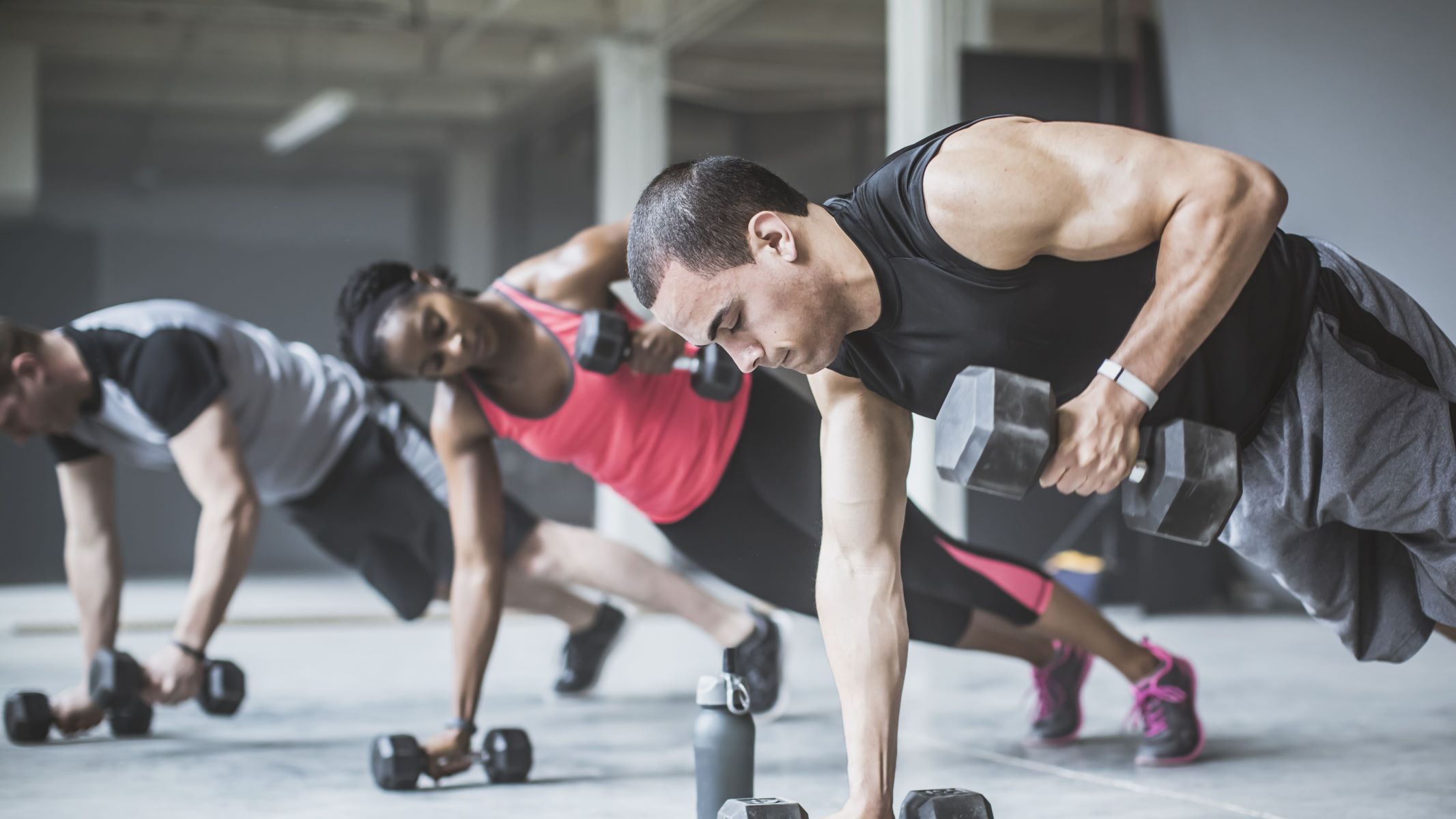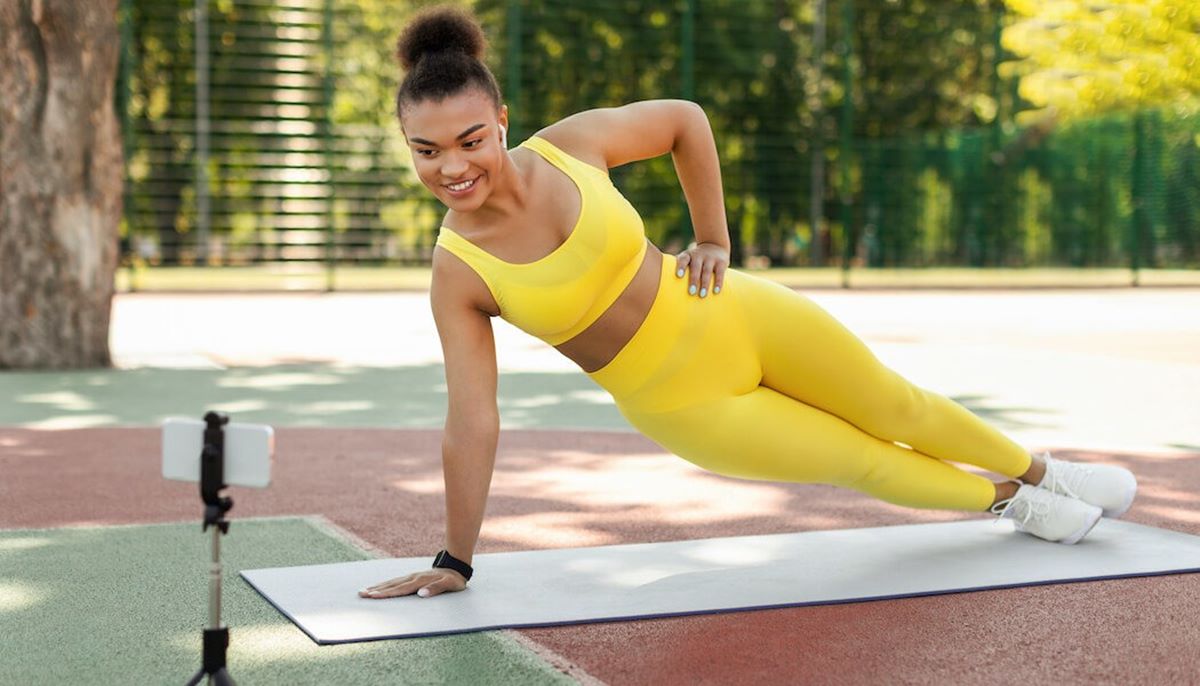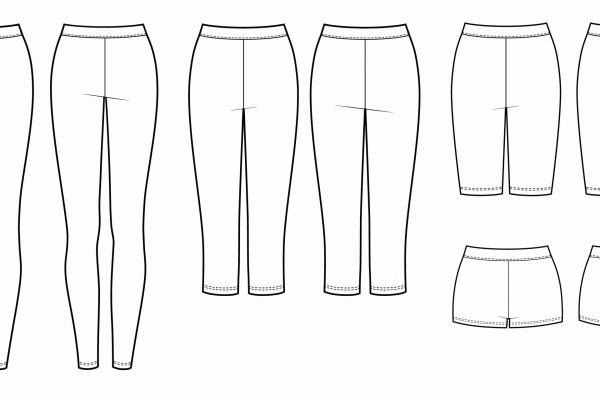

Types
What Should I Workout Today
Modified: May 22, 2024
Looking for different types of workouts? Discover the best options for your fitness routine and find out what you should workout today.
Introduction
Welcome to the world of fitness! Choosing the right workout routine can be an overwhelming task, especially with the wide variety of options available. Whether you’re a beginner or a seasoned fitness enthusiast, finding the perfect workout can make all the difference in your fitness journey.
Before diving into the various types of workouts, it’s important to understand that there is no one-size-fits-all approach. Each person’s fitness goals, preferences, and physical abilities are unique, and it’s essential to consider these factors before deciding on a specific workout regimen.
Factors such as your fitness goals, time availability, personal interests, and current fitness level should all be taken into account when choosing a workout routine. In this article, we’ll explore different types of workouts to help you find the one that best suits your needs and preferences.
Whether you’re aiming to increase strength, improve cardiovascular endurance, enhance flexibility, or engage in sport-specific training, there’s an abundance of options to choose from. From traditional gym workouts to outdoor activities and everything in between, the world of fitness is your playground.
Are you ready to embark on an exciting fitness journey? Let’s dive into the different types of workouts and discover which one is the perfect fit for you!
Factors to Consider Before Choosing Your Workout
Before jumping into any workout routine, it’s important to consider a few key factors that will influence your decision. By taking these factors into account, you can ensure that the chosen workout aligns with your goals, preferences, and lifestyle. Here are some essential factors to consider:
- Fitness Goals: Define your specific fitness goals. Are you looking to build muscle, lose weight, improve endurance, increase flexibility, or enhance overall fitness? Clearly identifying your goals will help you choose a workout that focuses on those specific areas.
- Time Availability: Consider your schedule and how much time you can commit to your workouts. Some workouts require a longer time commitment, while others are shorter and more intense. Find a routine that fits into your daily schedule without causing unnecessary stress or inconvenience.
- Physical Abilities: Be aware of your current physical abilities and any limitations you might have. This could include past injuries, health conditions, or mobility restrictions. It’s crucial to choose a workout that is safe and suitable for your body’s capabilities.
- Interests and Motivation: Select a workout that aligns with your interests and motivations. If you enjoy the activity, you’re more likely to stay committed and find joy in your fitness journey. Whether it’s dance, martial arts, or outdoor activities, there are countless options to keep you engaged and motivated.
- Access to Equipment or Facilities: Consider what equipment or facilities you have access to. Some workouts may require specialized equipment or a gym membership, while others can be done from the comfort of your own home or outdoors. Choose a routine that fits within your resources and available options.
- Personal preference: At the end of the day, your workout should be something you enjoy. Experiment with different activities and types of workouts to find what resonates with you. Remember that variety can also help keep your routine exciting and prevent boredom.
By evaluating these factors and taking them into consideration, you can make an informed decision about the workout routine that will best suit your needs and lifestyle. Remember, the right workout should be challenging, enjoyable, and sustainable in the long run.
Different Types of Workouts to Choose From
When it comes to choosing a workout, the options are endless. Each type of workout offers unique benefits for different fitness goals and preferences. Here are some popular types of workouts to consider:
- Strength Training: Also known as resistance training, this type of workout focuses on increasing muscle strength and tone. It typically involves using weights, resistance bands, or bodyweight exercises to target specific muscle groups. Strength training helps improve overall strength, increase metabolism, and enhance bone density.
- Cardiovascular Training: Also referred to as cardio, this type of workout aims to increase heart rate and improve cardiovascular endurance. Activities like running, cycling, swimming, dancing, and aerobics fall under this category. Cardiovascular training helps burn calories, improve heart health, and boost stamina.
- Flexibility and Mobility Training: Flexibility workouts, such as yoga and stretching, focus on improving flexibility, joint mobility, and range of motion. These workouts help enhance posture, reduce the risk of injury, and promote relaxation and stress relief.
- High-Intensity Interval Training (HIIT): HIIT workouts involve short bursts of intense exercise alternated with brief recovery periods. These workouts are efficient and time-saving while delivering maximum calorie burn and improving cardiovascular fitness. HIIT exercises can include exercises like burpees, sprints, jump squats, and more.
- Pilates or Yoga: Both Pilates and yoga are low-impact workouts that target core strength, balance, and flexibility. Pilates focuses on strengthening the core muscles, while yoga combines physical movement with mental and spiritual well-being.
- Sport-Specific Training: If you’re involved in a specific sport or activity, sport-specific training can help enhance your performance. For example, runners can benefit from interval training and hill sprints, while swimmers can focus on endurance exercises and technique drills.
- Outdoor Activities: Take advantage of the great outdoors by engaging in activities such as hiking, cycling, kayaking, or rock climbing. Outdoor workouts provide fresh air, varied terrain, and a change of scenery, making exercising more enjoyable.
- Cross-training: Cross-training involves combining different types of workouts to achieve overall fitness. It helps prevent boredom, reduces the risk of overuse injuries, and targets different muscle groups.
Remember, there’s no rule that says you have to stick to just one type of workout. You can mix and match different activities and exercises to create a well-rounded routine that keeps you motivated and engaged.
Strength Training
Strength training, also known as resistance training, is an essential component of any well-rounded fitness routine. It involves exercises and movements that target specific muscle groups, aiming to increase strength, improve muscle tone, and enhance overall physical performance.
Strength training can be done using various modalities, including free weights (such as dumbbells and barbells), weight machines, resistance bands, or even bodyweight exercises. The resistance applied to the muscles during strength training helps to stimulate muscle growth and provide numerous benefits for the body.
One of the primary benefits of strength training is the ability to increase muscle mass and strength. As you progressively challenge your muscles with resistance, they adapt and grow stronger over time. This leads to improved functional strength, making day-to-day activities easier and reducing the risk of injury.
Beyond building muscle, strength training also contributes to better bone health. Weight-bearing exercises help stimulate bone growth and increase bone density, which is crucial for preventing osteoporosis and maintaining overall bone strength as we age.
Strength training also plays a vital role in weight management. By increasing muscle mass, you can boost your metabolism, as muscles require more energy to maintain than fat. This means that even at rest, your body will be burning more calories. Additionally, strength training helps maintain or increase lean body mass while losing fat, ensuring a healthy body composition.
Besides the physical benefits, strength training can also have a positive impact on mental well-being. Engaging in regular strength training can help reduce stress levels, increase self-confidence, and improve overall mood. The sense of accomplishment and progress that comes from gradually increasing weights or mastering new exercises can boost self-esteem and enhance mental resilience.
It’s worth noting that strength training can be modified to suit individuals of all fitness levels and age groups. Beginners can start with lighter weights and focus on proper form and technique, gradually progressing to more challenging exercises. Working with a qualified fitness professional can ensure that you are following the right program and performing exercises correctly and safely.
Incorporating strength training into your routine can provide numerous health and fitness benefits. Whether your goal is to build muscle, increase strength, improve body composition, or enhance overall well-being, strength training is a crucial part of achieving those goals.
Cardiovascular Training
Cardiovascular training, often referred to as cardio, is a form of exercise that focuses on improving cardiovascular fitness and endurance. It involves activities that increase your heart rate and breathing rate, delivering oxygen to your muscles and improving overall cardiovascular health.
There is a wide variety of cardio exercises to choose from, such as running, cycling, swimming, dancing, aerobics, and jumping rope. These activities can be performed at varying intensities, making it accessible to individuals of all fitness levels.
Engaging in regular cardiovascular training brings about numerous benefits for the body. Firstly, it helps to strengthen the heart and improve blood circulation. By consistently challenging the cardiovascular system, you increase the heart’s efficiency, allowing it to pump oxygenated blood more effectively throughout the body.
Cardiovascular training is also highly effective for burning calories and managing body weight. By increasing the heart rate and engaging large muscle groups continuously, cardio exercises help to expend energy and facilitate weight loss or weight maintenance. Additionally, cardio workouts can help in reducing visceral fat, the type of fat that accumulates around the organs and poses a higher risk to health.
Regular cardio sessions also contribute to improving lung capacity and respiratory function. As you engage in aerobic exercises, the lungs are working harder to take in more oxygen and remove carbon dioxide efficiently. Over time, this leads to increased lung efficiency, allowing for better oxygen exchange during all daily activities.
Another significant benefit of cardiovascular training is the release of endorphins, also known as the “feel-good” hormones. When you engage in cardio exercises, the brain releases these hormones, creating a sense of well-being and reducing stress and anxiety levels. Cardio workouts can be an excellent way to boost your mood and improve mental health.
It is important to note that cardiovascular training can be customized to suit an individual’s fitness level and goals. Beginners can start with low-impact activities, gradually increasing the intensity and duration as their fitness level improves. High-intensity interval training (HIIT) is another popular cardio training method that involves alternating between periods of intense exercise and active recovery.
Regular cardiovascular training, combined with strength training and a balanced diet, forms the foundation of a comprehensive fitness routine. It not only improves cardiovascular health, but also aids in weight management, boosts overall mood, and enhances endurance for everyday activities. Incorporating cardio exercises into your fitness routine will undoubtedly have a positive impact on your overall health and well-being.
Flexibility and Mobility Training
Flexibility and mobility training focuses on improving joint range of motion, muscle elasticity, and overall flexibility. It incorporates exercises and stretches that help increase the length and suppleness of muscles and tendons, allowing for better movement and preventing injuries.
There are various methods and techniques for improving flexibility and mobility, including static stretching, dynamic stretching, yoga, and Pilates. These exercises target specific muscle groups and joints, helping to improve flexibility, balance, and body awareness.
One of the key benefits of flexibility and mobility training is the prevention of injuries. Improved flexibility reduces muscle imbalances, alleviates muscle tension, and enhances joint mobility. This can help decrease the risk of strains, sprains, and other common injuries during physical activities or in daily life.
In addition to injury prevention, flexibility and mobility training also help to improve posture and alignment. By stretching tight muscles and lengthening connective tissues, you can correct imbalances and relieve tension in the body. This promotes better posture, reduces muscle soreness, and prevents chronic pain caused by poor alignment.
Flexibility and mobility exercises also play a significant role in enhancing athletic performance. Increased joint range of motion allows for greater movement efficiency and optimal muscle activation. This can improve overall athletic performance, whether in sports, fitness activities, or even daily tasks.
Furthermore, flexibility and mobility training can provide mental and emotional benefits. Many exercises in this category, such as yoga, incorporate mindfulness and deep breathing techniques. This combination helps reduce stress, promote relaxation, and improve overall mental well-being.
It’s worth noting that flexibility and mobility training is not just for athletes or those already naturally flexible. Regardless of your current level of flexibility, incorporating regular stretching and mobility exercises into your routine can yield noticeable improvements over time. As with any type of training, consistency and gradual progression are key.
Flexibility and mobility exercises can be performed as a standalone session or incorporated into your warm-up and cool-down routine before and after other forms of exercise. They can be tailored to target specific areas of the body, such as the hips, shoulders, or spine, depending on your individual needs and goals.
By dedicating time to flexibility and mobility training, you can enhance your overall physical performance, reduce the risk of injuries, and improve your overall quality of life. So, make stretching and mobility a regular part of your fitness routine and reap the benefits of improved flexibility and freedom of movement.
High-Intensity Interval Training (HIIT)
High-Intensity Interval Training, commonly known as HIIT, is a workout method that alternates short bursts of intense exercise with brief recovery periods. This form of training has gained popularity due to its effectiveness in maximizing calorie burn, boosting cardiovascular fitness, and improving overall athletic performance.
HIIT workouts typically involve performing exercises at around 80-95% of your maximum effort for a short duration (usually 20-60 seconds) followed by a brief active recovery period. This cycle is repeated for several rounds, giving you the freedom to choose various exercises that target different muscle groups.
One of the primary benefits of HIIT is its efficiency. Due to the high intensity and intervals of intense effort, HIIT workouts can be completed in a relatively short amount of time, making them ideal for those with busy schedules. In just a 20-30 minute session, you can experience the same or even greater benefits compared to longer moderate-intensity workouts.
Another advantage of HIIT is its ability to boost cardiovascular fitness. The intense bursts of exercise push your heart rate higher than traditional steady-state cardio workouts, improving cardiovascular endurance and increasing your aerobic capacity. This translates into better stamina and the ability to sustain high-intensity activities.
HIIT workouts have been shown to be effective for fat loss. The intense nature of the exercises stimulates the body’s energy systems, resulting in an increased calorie burn both during and after the workout. This means that even after you’ve finished exercising, your body continues to burn calories at an elevated rate, contributing to weight loss and body composition improvements.
HIIT also has the potential to preserve muscle mass while burning fat. Unlike traditional steady-state cardio, which can lead to muscle loss, HIIT workouts can help maintain lean muscle mass due to the intense muscle contractions involved. This is beneficial for those looking to improve body composition and achieve a toned appearance.
Beyond the physical benefits, HIIT can also be mentally stimulating and time-efficient. The fast-paced nature of the workouts keeps you engaged and motivated, preventing boredom. The variety of exercises you can incorporate into HIIT sessions allows for creativity and the ability to tailor your workouts to your fitness goals.
While HIIT offers numerous benefits, it’s important to approach it with caution, especially if you’re new to exercise or have any underlying health conditions. It’s always recommended to start slowly, gradually increase the intensity and duration of your HIIT sessions, and listen to your body to avoid overexertion or injury.
Whether you’re short on time, looking to amp up your cardiovascular fitness, or aiming to maximize calorie burn, HIIT is a highly effective training method. By incorporating HIIT sessions into your fitness routine, you can achieve remarkable results in a shorter amount of time and challenge your body in new and exciting ways.
Pilates or Yoga
Both Pilates and yoga are low-impact workout methods that focus on improving strength, flexibility, balance, and overall mind-body connection. While they share similarities, each practice has its own unique principles and benefits, allowing individuals to choose the one that best suits their needs and preferences.
Pilates is a system of exercises developed by Joseph Pilates that focuses on strengthening the core muscles, improving posture, and promoting overall body alignment. It incorporates controlled movements and specific breathing techniques to engage the deep muscles of the abdomen, back, and hips. By strengthening the core, Pilates helps to stabilize the spine, improve overall body control, and prevent musculoskeletal imbalances.
On the other hand, yoga is an ancient practice originating from India that combines physical postures, breathing exercises, meditation, and relaxation techniques. Yoga aims to promote overall wellness by harmonizing the mind, body, and spirit. It offers various styles and levels of intensity, from gentle and restorative practices to more vigorous and challenging sequences.
Both Pilates and yoga offer numerous benefits for the body and mind. Regular practice can improve strength, flexibility, balance, and overall body awareness. They also promote relaxation, reduce stress, and enhance mental well-being.
When it comes to choosing between Pilates and yoga, it’s essential to consider your goals and preferences. Pilates primarily focuses on building core strength, improving posture, and targeting specific muscle groups. It’s a good choice for those looking to improve overall body control and muscular endurance.
Yoga, on the other hand, offers a more holistic approach, combining physical postures with breathwork and mindfulness. It provides an opportunity to cultivate a deeper mind-body connection, relieve stress, increase flexibility, and improve balance. There are various styles of yoga available, such as Hatha, Vinyasa, Ashtanga, and Yin, each with its own focus and intensity level.
Both practices can be modified to suit different fitness levels and are accessible to individuals of all ages. Whether you’re a beginner or an experienced practitioner, instructors can guide you through proper technique and offer modifications to ensure a safe and effective practice.
Ultimately, the choice between Pilates and yoga comes down to personal preference and goals. Some individuals may prefer the precise and controlled movements of Pilates, while others may resonate more with the meditative and flowing nature of yoga. You can even incorporate elements of both practices into your fitness routine, allowing you to benefit from the unique advantages of each.
Regardless of which practice you choose, both Pilates and yoga offer a holistic approach to fitness and well-being. Whichever path you decide to embark on, both practices can help you develop strength, flexibility, and a deeper connection with your body and mind.
Sport-Specific Training
Sport-specific training is a specialized form of exercise aimed at improving performance in a specific sport or activity. Whether you’re a professional athlete or a recreational sports enthusiast, incorporating sport-specific training into your fitness routine can take your skills and abilities to the next level.
The primary goal of sport-specific training is to develop the specific physical attributes required for a particular sport or activity. This type of training focuses on enhancing the skills, strength, agility, speed, endurance, and coordination needed to excel in that particular sport.
Each sport has its own unique demands and physical requirements. For example, a basketball player may need to focus on vertical jump training, speed, and quickness drills, as well as improving hand-eye coordination. A tennis player, on the other hand, may work on explosive movements, footwork, and rotational strength.
Sport-specific training involves exercises and drills that mimic the movements and intensity of the sport. These workouts aim to replicate the demands of the sport and target the specific muscle groups used. By training in a sport-specific manner, athletes can improve their performance in areas such as power, speed, agility, endurance, and sport-specific skills.
In addition to physical attributes, sport-specific training can also improve mental and strategic aspects of the game. As athletes practice and hone their skills, they develop a deeper understanding of the sport’s intricacies, enabling them to make quick decisions and react more effectively during gameplay.
Utilizing a comprehensive sport-specific training program is essential to ensure balanced development and injury prevention. It is important to work with a qualified coach or trainer who understands the specific requirements of your sport and can tailor a program specific to your needs and goals.
Sport-specific training can benefit athletes of all levels and ages. Even if you’re not competing at a professional level, incorporating sport-specific exercises into your routine can enhance your enjoyment and performance in your chosen sport or activity. It enables athletes to train more efficiently and effectively, improving their skills and overall physical fitness.
Remember, sport-specific training should be accompanied by a solid foundation of general strength and conditioning exercises. It’s essential to develop a well-rounded fitness base that includes cardiovascular fitness, strength training, flexibility, and core stability in order to support the demands of your sport-specific workouts.
Whether you’re training for a competitive event or simply looking to improve performance in your favorite sport, sport-specific training can unlock your full athletic potential and help you excel on the field, court, or any other playing surface.
Outdoor Activities
Outdoor activities offer a refreshing and invigorating way to stay fit while enjoying the beauty of nature. Whether you’re exploring local hiking trails, cycling along scenic routes, or engaging in water sports, outdoor activities provide endless opportunities to improve your fitness and overall well-being.
Outdoor activities offer a wide range of physical and mental benefits. The natural environment provides fresh air, sunlight, and a change of scenery that can enhance mood, reduce stress, and increase overall happiness. The combination of physical exertion and immersion in nature creates a sense of relaxation and rejuvenation.
One of the key advantages of outdoor activities is the variety of exercises they offer. Hiking allows you to engage in a full-body workout, using different muscle groups while traversing uneven terrains and elevations. Cycling provides a low-impact cardiovascular workout, improving endurance and leg strength. Water sports such as kayaking, paddleboarding, or swimming offer a fun and effective way to work multiple muscle groups while enjoying the water.
Engaging in outdoor activities also promotes functional fitness. Walking or hiking on uneven trails activates stabilizer muscles and challenges balance, improving overall stability and coordination. These activities often involve natural movements such as climbing, jumping, and carrying, which translate into real-life scenarios that require strength, agility, and endurance.
Another significant benefit of outdoor activities is the ability to vary your workouts. Nature provides an ever-changing landscape, allowing you to explore different routes, terrains, and challenges. This variety keeps your workouts exciting and prevents monotony, enabling you to continuously push your limits and improve your fitness level.
Outdoor activities also offer the opportunity for social connection and community engagement. Engaging in group activities, such as hiking clubs or team sports, fosters camaraderie and a sense of belonging. Sharing outdoor experiences with others can enhance motivation, accountability, and support, making workouts more enjoyable and memorable.
While outdoor activities offer numerous advantages, it’s essential to prioritize safety. Be sure to familiarize yourself with the specific activity or sport, wear appropriate gear and clothing, and check weather conditions before heading out. Additionally, always respect and appreciate the natural environment by practicing Leave No Trace principles and following local regulations.
Whether you’re a seasoned outdoor enthusiast or new to the world of outdoor activities, getting outside and connecting with nature is a fantastic way to improve both physical fitness and overall well-being. So, lace up your hiking boots, grab your bike, or hit the water – the great outdoors is waiting for you!
Cross-training
Cross-training is a fitness approach that involves incorporating a variety of different exercises and activities into your workout routine. Rather than focusing solely on one type of exercise, cross-training combines various forms of physical activity to achieve a well-rounded and balanced fitness regimen.
The goal of cross-training is to target different muscle groups, improve overall fitness, and prevent overuse injuries. By engaging in a variety of exercises, you can challenge your body in different ways and avoid the plateau effect that can occur when doing the same workout repeatedly.
Cross-training typically involves a combination of cardiovascular exercises, strength training, flexibility training, and even activities like yoga or Pilates. This variety works different muscle groups, improves endurance, enhances flexibility, and promotes overall athleticism.
One of the primary benefits of cross-training is the ability to build a strong and well-rounded physique. By incorporating different exercises, you can work on all aspects of fitness, including cardiovascular fitness, muscular strength and endurance, flexibility, and balance. This comprehensive approach helps improve overall body composition and functional fitness.
Another advantage of cross-training is the ability to prevent overuse injuries. When you repeatedly perform the same movements or exercises, it can strain specific muscles and joints. By incorporating different activities, you distribute the workload and reduce the risk of overuse injuries. For example, if you’re a runner, cross-training with swimming or cycling can help you maintain cardiovascular fitness while reducing the impact on your joints.
Additionally, cross-training can prevent workout boredom and keep you motivated. Trying new activities and workouts challenges your body and mind, making your exercise routine more enjoyable. This variety not only makes training more fun, but it also helps you stay committed and consistent with your fitness goals.
It’s important to customize your cross-training routine to suit your specific goals, interests, and fitness level. You can work with a fitness professional to develop a well-balanced plan that includes a mix of exercises tailored to your needs and preferences.
Remember to listen to your body and allow for proper rest and recovery. Cross-training is an excellent way to challenge your body, but it’s crucial to avoid overtraining and give your muscles time to repair and rebuild.
Incorporating cross-training into your fitness routine offers countless benefits for both physical and mental well-being. By diversifying your workouts and challenging your body in different ways, you can achieve a higher level of fitness, prevent injuries, and keep your workouts exciting and enjoyable.
Listen to Your Body
When it comes to exercise and fitness, one of the most essential principles is to listen to your body. Your body has its unique needs and signals, and tuning in to them can help you make informed decisions about your workouts, avoid injuries, and maximize the benefits of your fitness routine.
Listening to your body starts with recognizing and respecting your physical limits. Pay attention to any discomfort, pain, or unusual sensations during your workouts. Pushing through pain or ignoring warning signs can lead to injuries or exacerbate existing ones. Instead, take a break, modify your exercises, or seek guidance from a fitness professional to prevent further harm.
Rest and recovery are vital components of any fitness program. Your body requires time to repair and rebuild after exercise in order to grow stronger. Ignoring the need for rest can result in overtraining, fatigue, and decreased performance. Be mindful of your energy levels, and give yourself regular breaks to allow your body to recharge and heal.
Maintaining balance is key to long-term fitness success. While it’s important to challenge yourself and push boundaries, it’s equally important to listen to your body’s need for rest and relaxation. Pushing too hard without proper recovery can lead to burnout and diminished motivation. Finding the right balance between challenging workouts and restorative practices is crucial to achieving sustainable progress.
Beyond physical cues, listening to your body involves being attuned to your emotional and mental well-being. Exercise can be a great stress reliever, but it’s important to recognize when it’s becoming a source of stress or anxiety. If a particular workout or fitness routine is causing excessive pressure or negatively impacting your mental health, consider exploring alternative activities that bring you joy and enhance your well-being.
Flexibility is also part of listening to your body. Your fitness journey may have its ups and downs, and it’s important to adapt as needed. Your body might require changes in your workout intensity, duration, or even type of exercise. Listening to your body allows you to modify your fitness routine to meet your current needs and goals.
A crucial aspect of listening to your body is establishing a strong mind-body connection. This means being present during your workouts, paying attention to how your body moves, and being mindful of the sensations and feedback it provides. This connection allows you to make adjustments in real-time, ensuring that your workouts are effective, safe, and enjoyable.
Remember that every individual is unique, and what works for someone else may not work for you. Embrace your body’s individuality and honor its needs. By listening to your body and respecting its limits, you can create a fitness routine that promotes health, happiness, and longevity.
Conclusion
Choosing the right workout routine is crucial for achieving your fitness goals and maintaining a healthy lifestyle. By considering factors such as your goals, time availability, physical abilities, interests, and access to equipment or facilities, you can make an informed decision about which workout is best suited for you.
Whether you opt for strength training, cardiovascular training, flexibility and mobility training, high-intensity interval training (HIIT), Pilates or yoga, sport-specific training, outdoor activities, or cross-training, each type of workout offers unique benefits and caters to different aspects of physical fitness.
Strength training helps to build muscle, improve bone density, and increase metabolism. Cardiovascular training boosts heart health, burns calories, and enhances endurance. Flexibility and mobility training improves joint range of motion and prevents injuries. HIIT delivers high-intensity calorie-burning workouts in a short amount of time. Pilates or yoga combine physical movement with mental and spiritual well-being. Sport-specific training enhances performance in a particular sport or activity. Outdoor activities provide a refreshing and invigorating way to stay fit while embracing the beauty of nature. Cross-training offers a well-rounded fitness approach that incorporates various exercise modalities.
Listening to your body is a vital aspect of any fitness routine. Being aware of your physical limits, recognizing signs of fatigue or pain, and prioritizing rest and recovery are essential for injury prevention and overall well-being. Balancing challenging workouts with restorative practices ensures optimal progress and prevents burnout.
Incorporating different types of workouts into your fitness regimen can provide a well-rounded approach that targets multiple aspects of fitness, prevents boredom, and maximizes results. Ultimately, the key to a successful workout routine is finding activities that you enjoy and that align with your goals, preferences, and lifestyle.
Embrace the journey and be open to exploring new workout modalities. Your fitness routine should be flexible, adaptable, and sustainable. By finding the perfect workout for you and listening to your body along the way, you can embark on a fulfilling fitness journey and unlock your full athletic potential.







